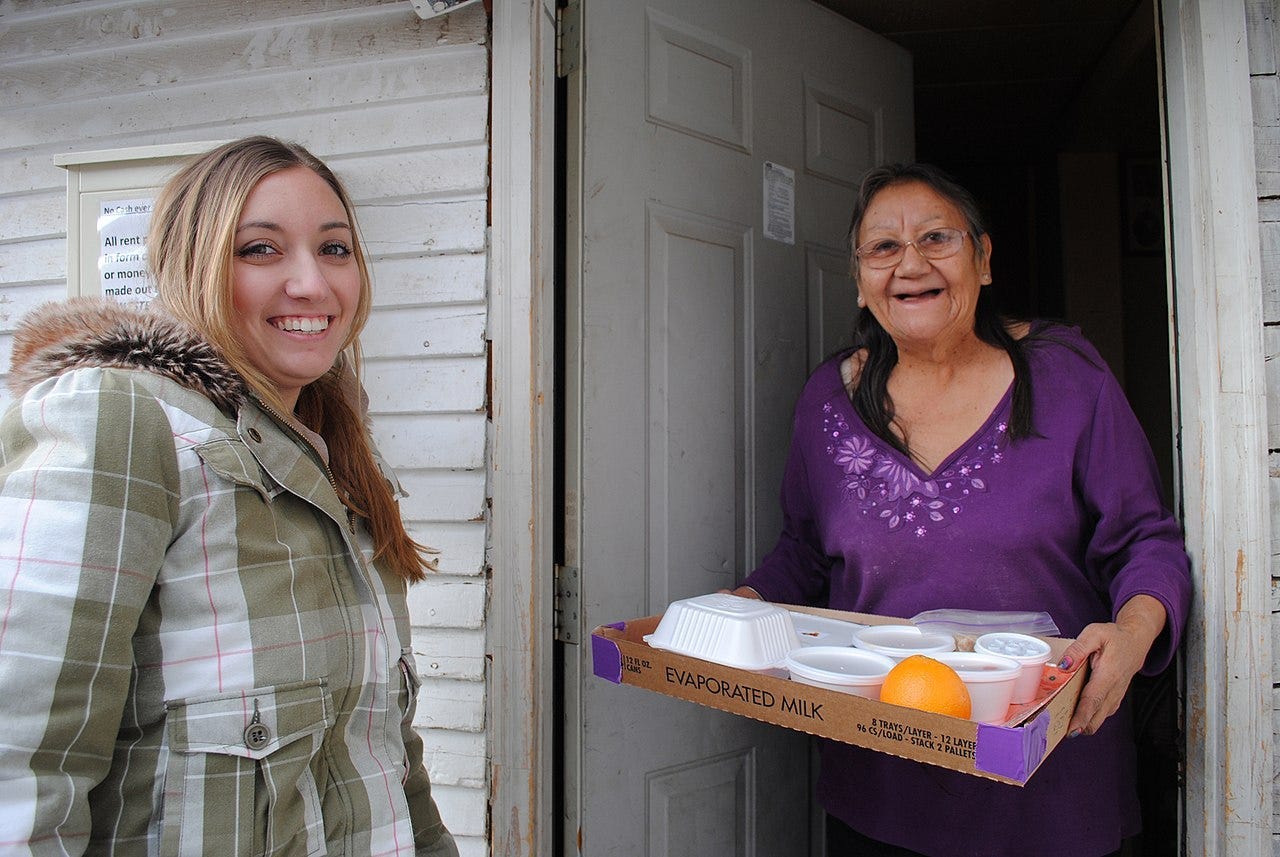The Looming Nutrition Crisis Facing America’s Oldest Adults
Millions may go hungry as Meals on Wheels braces to lose critical support

Long before DoorDash or Uber Eats, there was Meals on Wheels — a program that delivers food to low-income American seniors.
One of those grateful recipients was my Grandma. Thanks to its services, Grandma was able to stay in her home for many years. (And this was despite being blind and recuperating from cancer!)
Today, millions of frail and homebound seniors rely on Meals on Wheels for hot, nutritious meals delivered by local volunteer community members. Part of the Older Americans Act, it’s been in operation for over half a century.
However, the popular program may now have reached a dead end. President Trump’s budget reconciliation package (aka his “One Big Beautiful Bill”) is the law of the land. And millions of older adults may go hungry as a result of the bill’s deep cuts to Medicaid and food assistance programs.
A lifeline for seniors
Meals on Wheels (MOW) home-delivers an estimated 250 million meals to 2.2 million older Americans. For the many older adults who are food insecure, as well as those grappling with the nutrition challenges that come with aging, it’s a veritable lifeline.
But the service is about more than just food. Often, the volunteers delivering the meals are the recipients’ only regular human contact. They provide not only a smiling face but also vital services — including wellness checks, safety scans, and connections to needed social services.
“Getting to know the seniors on my routes has been one of the greatest privileges of my life,” Maryellen Kennedy Duckett, a MOW volunteer driver in Delaware County, Pennsylvania, told me. “Every one of my clients has a unique story to tell and I love hearing them all.”

Slash and burn
As the provisions of the “big beautiful bill” take effect, Meals on Wheels faces several big challenges. Chief among them are major cuts to key funding streams.
Meals on Wheels receives nearly 40% of its dollars through the Older Americans Act, administered through the Department of Health and Human Services (HHS), which itself faces a $32 billion cut. Additionally, several essential block grants are on the chopping block.
Tightened funding will also lengthen wait lists for services, which are already stretched thin due to flat funding. In many areas, wait times exceed four months. In other communities, the delay can be as long as two years.
Across the country, sidelined older adults struggle to stay afloat. In San Francisco, a blind 79-year-old subsists on apples and nuts. Near Baltimore, a couple aged 89 and 91 share a single daily meal. A senior living in a trailer in rural Nebraska survives on rice and biscuits with gravy.
In Texas and Arizona, the uncertainty around funding has imposed new barriers. “All across Texas, other Meals on Wheels programs are seeing the same thing that we are seeing,” Jackie Hamm, CEO of Meals on Wheels Wichita County, recently told a local TV station. “The waiting lists, the rising costs, the food, all of these things, the fewer dollars that are going around.”
The answer is in plain sight
While the “big beautiful bill” purports to cut costs and improve efficiency, MOW officials say hobbling the program accomplishes exactly the opposite. They point to a 2023 comprehensive review of scientific studies that concludes Meals on Wheels not only improves seniors’ health but also reduces healthcare costs.
After poring over findings from 38 diverse studies — including randomized controlled trials, statistical modeling reports, and peer-reviewed journal articles — researchers found the following evidence of the program’s value:
And the cost savings are significant. Josh Protas, MOW’s Chief Advocacy and Policy Officer, pointed out, “We can feed a senior for an entire year for roughly the same cost as one day in the hospital, or 10 days in a nursing home.”
Hold on to your pocketbook
To offset the cost of extending trillions of dollars in tax cuts to the wealthy, Trump’s “big beautiful bill” cuts about $1 trillion from Medicaid, the government health insurance program for low-income Americans. But it’s not just “the poor” who will suffer. The results will be felt by everyone.
A natural law of the American healthcare system is that if costs increase in one part, they’re transferred to another. Costs increase for everyone. (Not to mention that taking food from low-income seniors is cruel and draconian.)
Remember the older woman living in a trailer in rural Nebraska, subsisting on rice and biscuits with gravy while she waited for food services? Here’s how she described her dilemma: “The country doesn’t want to admit there’s poverty. We can feed the world, but not our own.”
Senator Angus King, an independent from Maine, speaking on the Senate Floor recently, put it more bluntly: “Imagine a bunch of guys sitting around a table saying, ‘I’ve got a great idea. Let’s give $32,0000 worth of tax breaks to a millionaire, and we’ll pay for it by taking health insurance away from lower-income and middle-income people. And to top it off, how about we cut food stamps, we cut SNAP, we cut food aid to people?’ I have never seen a bill that is this irresponsible, regressive, and downright cruel.”
Asked how funding cuts will affect the seniors she serves, Duckett, the MOW volunteer, said, “I’m not being dramatic when I say that I have no idea how some of my clients will survive. Meals on Wheels offers meals, dignity, community connections, and independence to seniors. So I can’t comprehend how taking that away makes America ‘great.’”







It does not speak well for our society that we choose to impart suffering on those least likely to have the power of advocacy. Excellent and important piece.
Once we attach a person's face and his/her story to an "issue," we get how important it is to care for those who are most vulnerable. Thanks for this solid explanation, Kathleen.